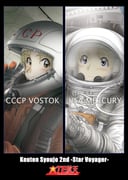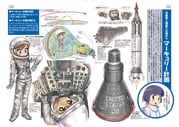Edit
Project Mercury was the first human spaceflight program of the United States. It ran from 1959 through 1963 with the goal of putting a human in orbit around the Earth and do it before the Soviet Union as part of the early space race.
Because of their small size, it was said that the Mercury spacecraft were worn, not ridden. With 1.7 m³ of habitable volume, the spacecraft was just large enough for the single crew member. Inside were 120 controls: 55 electrical switches, 30 fuses and 35 mechanical levers. The spacecraft was designed by Max Faget and NASA's Space Task Group.
Despite the astronauts' test pilot experience NASA at first envisioned them as "minor participants" during their flights, causing many conflicts between the astronauts and engineers during the spacecraft's design. Nonetheless, contrary to other reports, the project's leaders always intended for pilots to be able to control their spacecraft, as they valued humans' ability to contribute to missions' success. John Glenn's manual attitude adjustments during the first orbital flight were an example of the value of such control. The astronauts requested —and received— a larger window and manual reentry controls.



